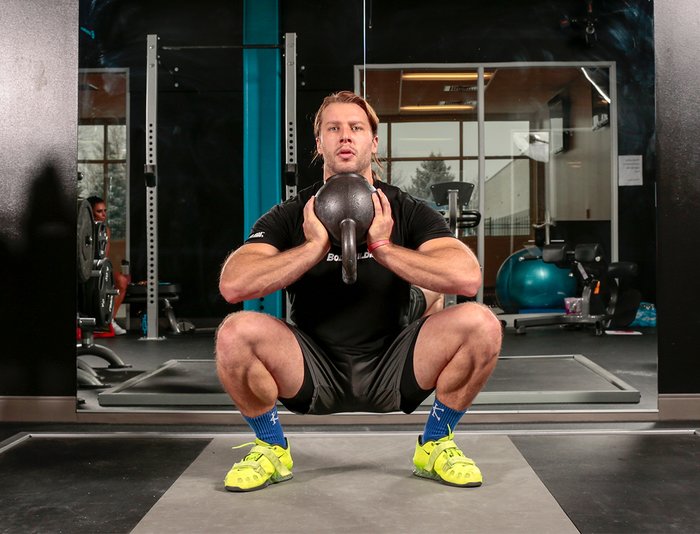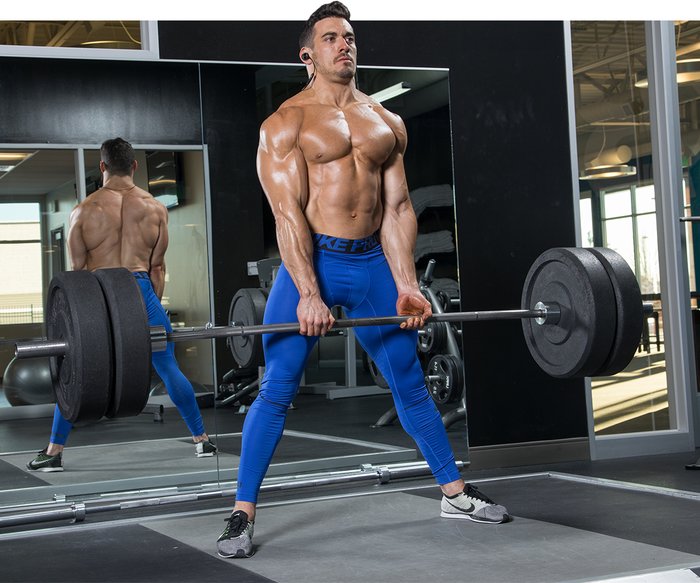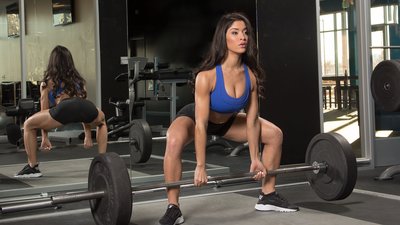When was the last time you got on your gym's abductor or adductor machine and got in a good workout? It's probably been a while. Both are machines that don't get a lot of use, and they are often the target of coaches' ridicule on those "useless gym moves we should all skip" lists. Perhaps rightly so, especially if you're hopping on those machines hoping for a slimming effect.
But that doesn't mean the muscles these machines hit—the hip rotators—don't need any love. Far from it.
Strong, injury-resistant athletes have strong hips. This holds true if you're playing a quick-paced sport with lots of lateral movement, like tennis or basketball, but also if you're just a lifter who wants to move weight and not be in pain doing it.
If you're interested in building hip strength that counts, but not interested in experiencing the indignity of the leg-spreading machines, you thankfully have other—and better—options.
Why You Need to Get Hip
The hip abductors and adductors are considered an antagonistic pair: As one muscle group contracts, the other group relaxes. The abductors, including the gluteus medius, gluteus minimus, tensor fasciae latae, sartorius, and piriformis, are responsible for moving your leg away from your body's midline.
In essence, every time you take a lateral step, or swing your leg off the side of the bed, your abductors are contracting. The adductors, primarily the adductor magnus, minimus, brevis, and longus (with the gracilis and pectineus playing a part), perform the opposite role, contracting whenever you need to draw your leg toward your body's midline.
The abductors in particular are notoriously weak in many people, which can potentially contribute to back pain, among other problems. Weak adductors are a notorious contributor to both groin strains and knee pain. So yes, they matter. Now here's how to train them.
1. Wide-Stance Squat Below Parallel
Every leg workout should include a squat variation. This closed-chain, compound movement targets just about everything in your lower body, including your inner and outer thighs. But to really hammer your hips, you should to be going deep and turning your toes out.
Josha Kruvand, the founder and owner of Kru Strength + Fitness, points specifically to a 2010 study that assessed squat depth and external hip rotation. The goal of the study was to analyze the recruitment of the abductor group during a squat.

Researchers found that squats at or below parallel, and those with at least a 30-degree external rotation of the hips (achieved by angling the toes slightly outward), were much better at targeting the abductor group than those with less knee flexion or internal hip rotation.[1]
What does this mean for you? At least some of your squats should look like this:
- Stand tall with your feet roughly at or slightly wider than shoulder-width apart. Angle your toes outward at between 30 and 50 degrees. Engage your core and check your posture, making sure your shoulders are back and your chest is up.
- Press your hips back and lower your glutes toward the ground, keeping your weight in your heels. As you bend your knees, you'll have to engage your abductor groups to keep your knees aligned with your toes.
- When your hips drop below 90-degrees, pause, then reverse the movement by pressing through your heels, extending your knees and hips, and returning to standing.
You can perform this exercise with or without added weight, such as barbells, dumbbells, or kettlebells. More important than the implement you choose is that you maintain perfect form, with your knees tracking your toes.
2. Sumo Deadlift
The sumo deadlift uses a similar foot position as the wide-legged squat, and it's this external rotation of the hips that leads to the enhanced engagement of the inner and outer thighs.

"As compared to a conventional deadlift, the sumo allows for greater recruitment of the adductors and a more stabilizing emphasis for the abductors," says Lindsey Cormack, a competitive powerlifter and CrossFit trainer. "Training sumo may feel less stable at first, but the balance requirement is what allows you to effectively train both the abductors and adductors."
- Stand behind a loaded barbell, positioning your feet wide, with your toes angled outward. Engage your core and roll your shoulders back to ensure you have good posture. Alternately, you can use a kettlebell, or a dumbbell on its side.
- Press your hips back and lean forward, reaching your arms straight down to grasp the weight. Bend your knees and lower your glutes toward the ground.
- Take a deep breath in, and, on your exhale, drive through your heels, extending your knees and hips in tandem as you return to standing. Press your hips forward at the top of the movement, drawing your shoulder blades together and pushing your chest forward.
- Reverse the movement in a controlled fashion, pressing your hips back before bending your knees and lowering your glutes toward the ground.
If you haven't performed a lot of these, you will definitely be sore down south for a while after your first workout. Consider that a sign that your hips needed some attention.
3. Side-Lying Hip Abduction
A 2005 study, published in the Journal of Orthopaedic and Sports Physical Therapy, found that the non-weight-bearing, side-lying hip abduction was as effective at recruiting the gluteus medius (one of the primary hip abductors) as other, weight-bearing exercises.[2]
You may think you don't need to take a physical-therapy-based approach to your hips, but you might be wrong. Truly weak hip muscles need isolated attention, not just the hammering that heavy squats and sumo deadlifts can inflict.
The fact that you don't need weights for this exercise makes it a great isolation movement. Dr. Alice Holland, of Stride Strong Physical Therapy, points to the side-lying hip abduction as one of her favorites. She notes that runners and athletes often struggle with it—which means they need it more than anyone.
"I think this is the cleanest open-chain exercise for the abductors, since it correctly targets the fibers of the gluteus medius and minimus," Holland says.
She says 3 sets of 10 is enough to fatigue most people, and the more often you do them, the better.
- Lie on your side with your hips stacked on top of each other. Position your top leg behind your front leg by about 5 degrees, so your top heel is behind you.
- Keeping your core engaged and your knee straight, lift your top ankle up toward the ceiling without moving your pelvis at all. Brace yourself with your hands or elbows as needed.
- Return your top foot to the starting position and continue, maintaining a slow and steady pace, and perfect, controlled form.
4. Side-Lying Hip Adduction
In scientific electromyography testing, the side-lying hip adduction outperformed five other exercises (including sumo squats and side lunges) for activation of the adductor longus muscle.[3]
Like its abduction counterpart, the adduction exercise can be performed anywhere since you don't need anything to do it except a comfortable mat. This makes it a great move to add to your core routine or after squeezing in a quick home workout.
- Lie on your side on the floor with your hips stacked vertically, one on top of the other. Engage your core and brace yourself, using your hands or elbows as needed. Make sure your hips remain fixed and perpendicular to the floor.
- Keeping your torso and hips steady, bend your top knee and draw your foot toward your hips, planting it in front of your bottom leg.
- Engage the adductors of your lower leg and lift your leg as high off the floor as you can without rotating or tilting your pelvis (probably only a few inches). Hold for a second at the top of the movement, then slowly lower your leg back to the starting position.
If back pain, knee pain, or SI joint pain are part of your life, give all of these movements a try. Don't forget about your hips! If you do, they may very well decide to remind you why they're important after all.
References
- Pereira, G. R., Leporace, G., das Virgens Chagas, D., Furtado, L. F., Praxedes, J., & Batista, L. A. (2010). Influence of hip external rotation on hip adductor and rectus femoris myoelectric activity during a dynamic parallel squat. The Journal of Strength & Conditioning Research, 24(10), 2749-2754.
- Bolgla, L. A., & Uhl, T. L. (2005). Electromyographic analysis of hip rehabilitation exercises in a group of healthy subjects. Journal of Orthopaedic & Sports Physical Therapy, 35(8), 487-494.
- Delmore, R. J., Laudner, K. G., & Torry, M. R. (2014). Adductor longus activation during common hip exercises. Journal of Sport Rehabilitation, 23(2), 79-87.

